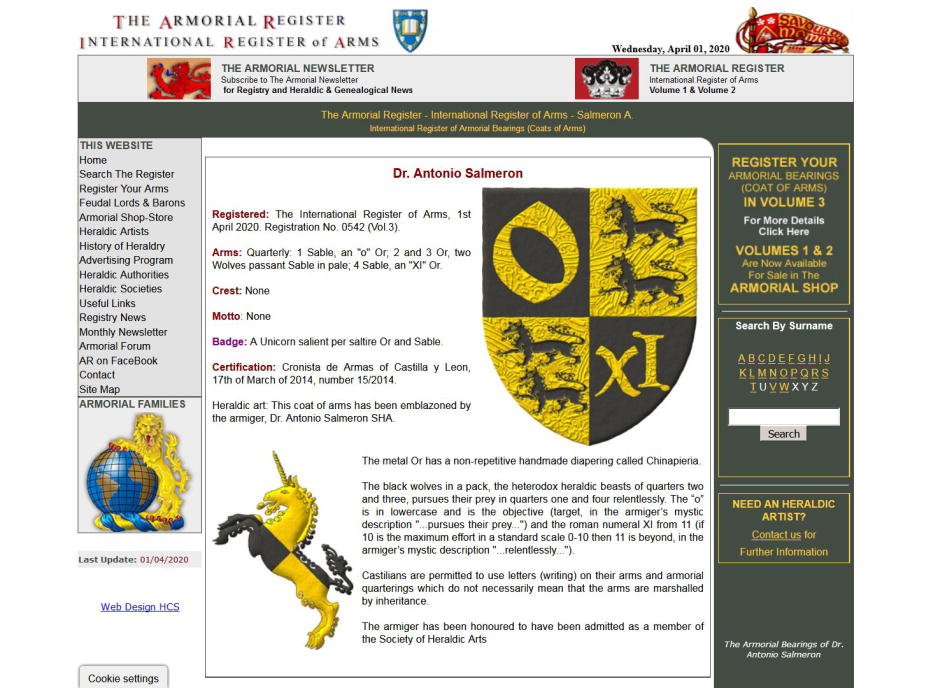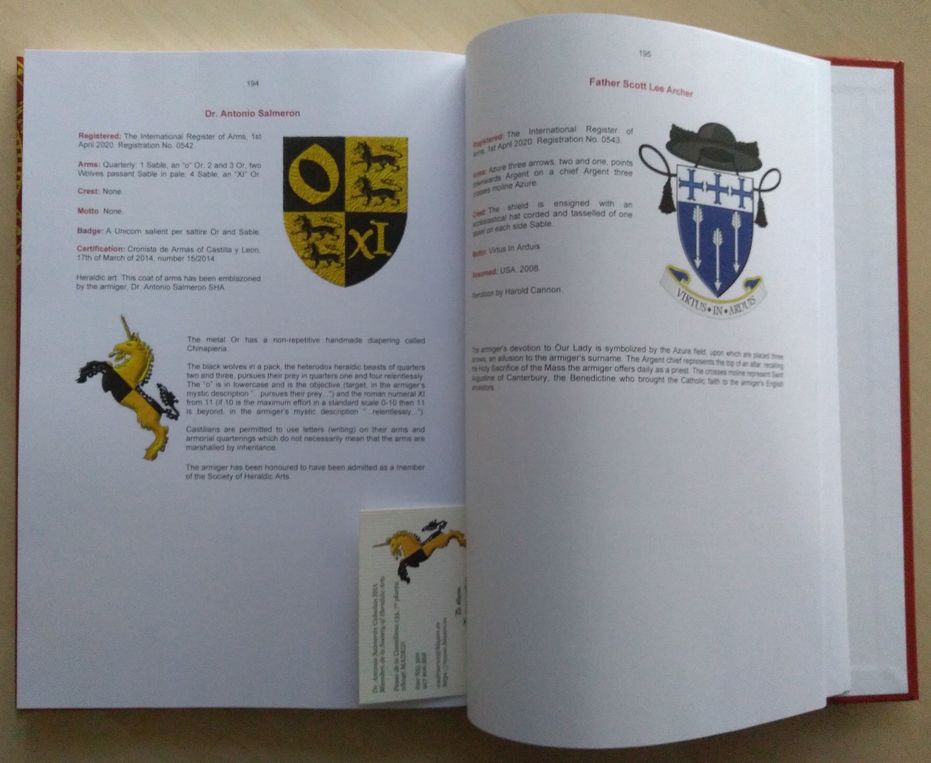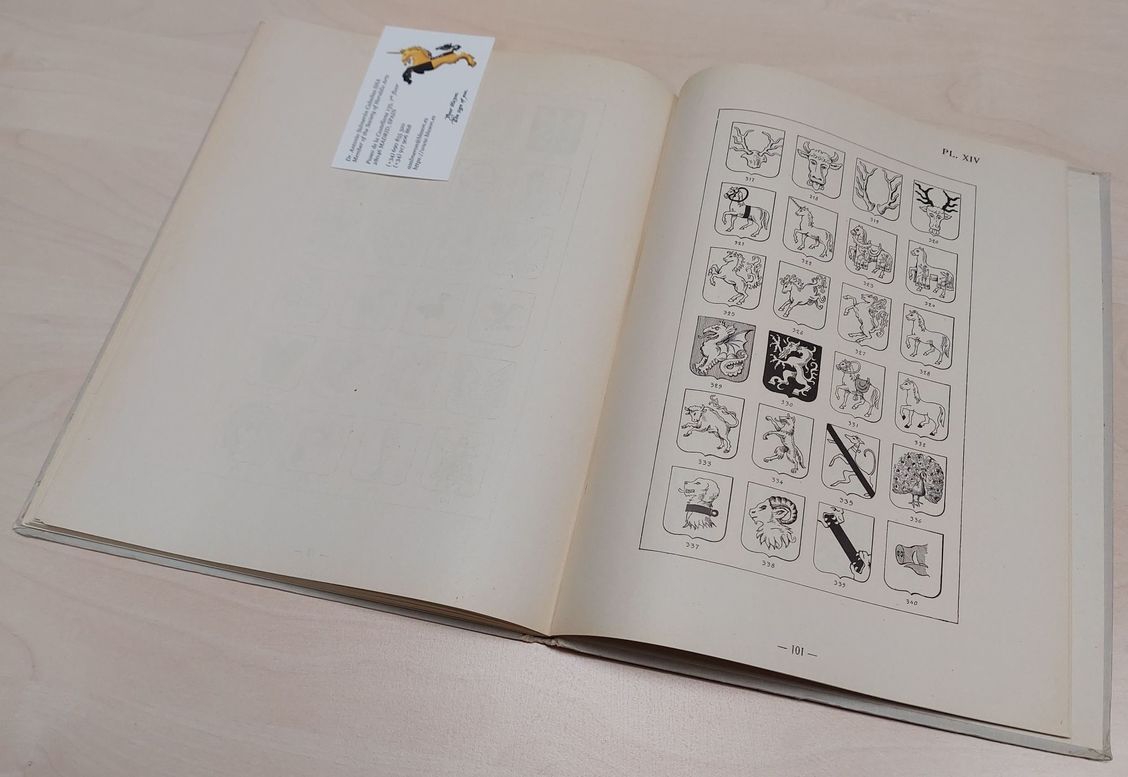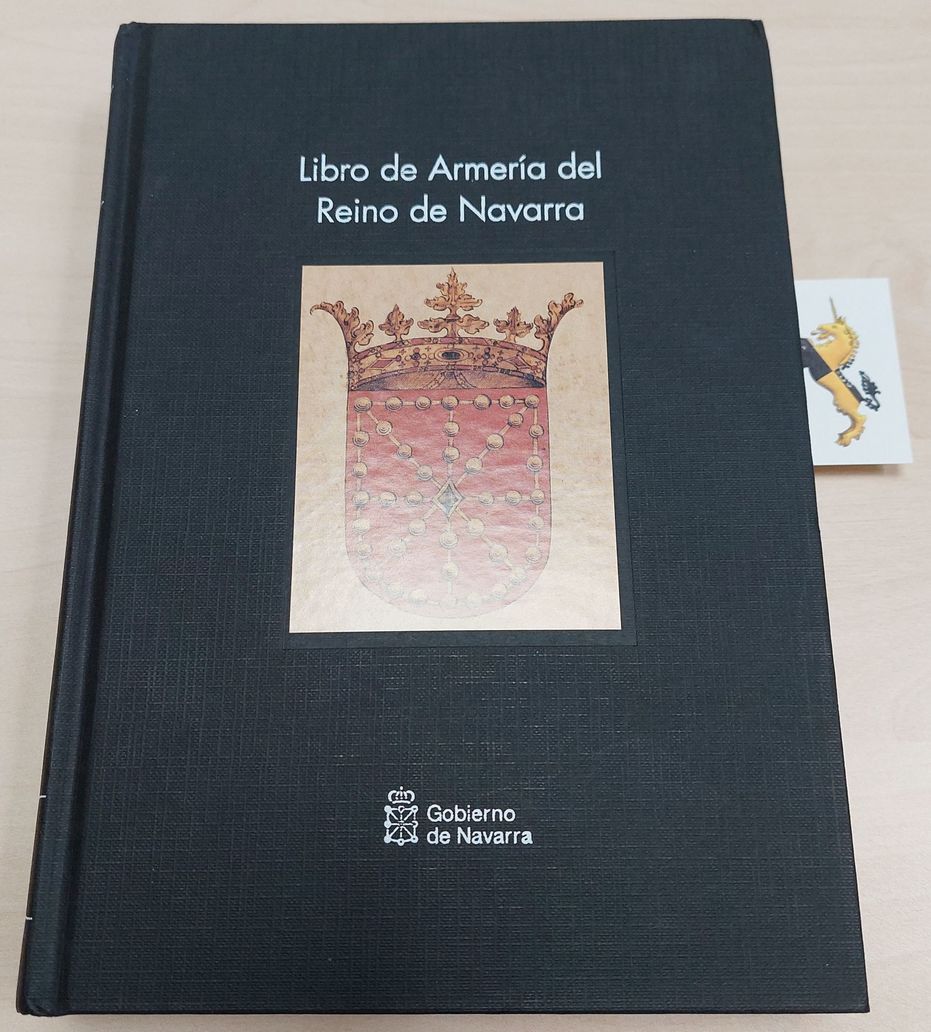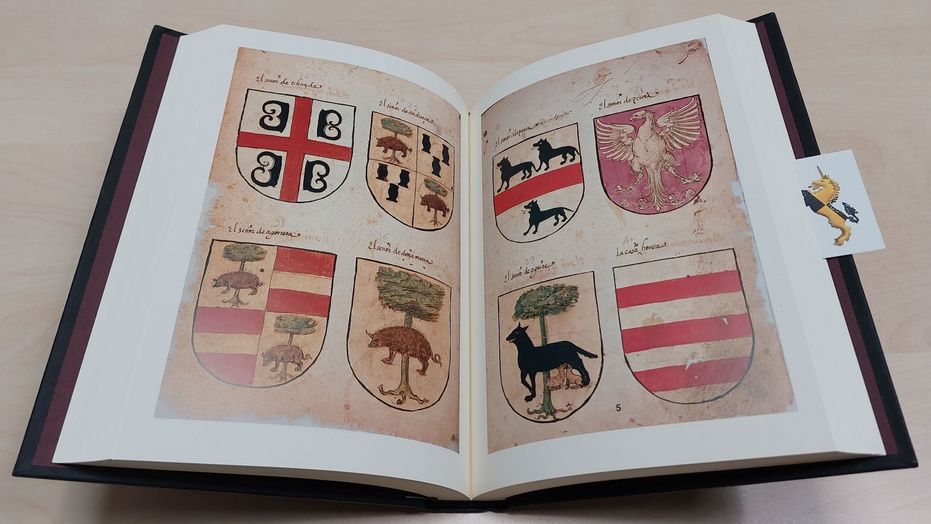
Badge of The Knights of Cristina
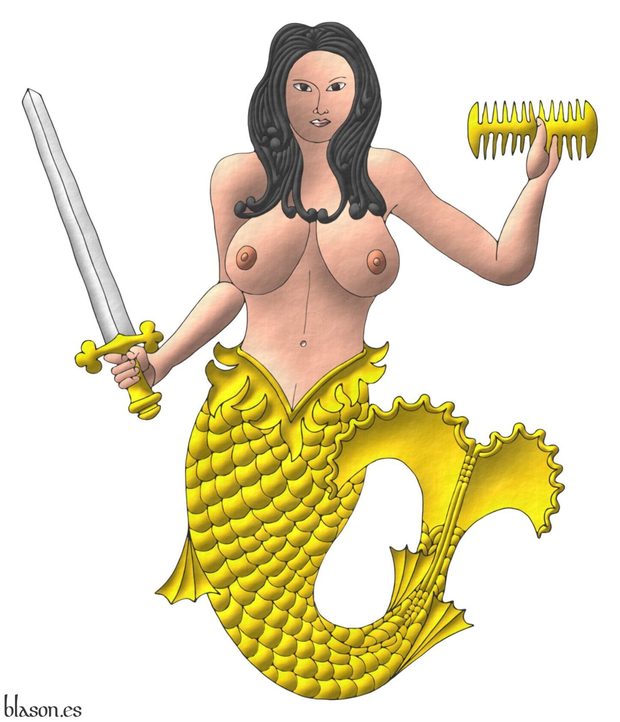
A mermaid proper, holding in her dexter a sword Argent, hilted Or, and in her sinister a comb Or.
Heraldic device designed by me, highlighted with lights and shadows, contoured in Sable, and with a rough finishing.
The heraldic badge of The Knights of Cristina designed under her directions and emblazoned by me.
Blazon keywords: Argent, Or, One, Mermaid, Proper, Grasping, Dexter, Sword, Hilted, Sinister and Comb.
Style keywords: Outlined in sable, Illuminated and Rough.
Classification: Imaginary, Created, Boa and Badge.
Imaginary bearer: Cristina, The Knights of.


![Ver [Rumor, S.; 1899] en referencias bibliográficas. Libro abierto, hojas de plata, filo de oro, guardas de gules, tapas de sable.](../css/Libro.Bibliografia.png)
Rumor, S.; 1899
Sebastiano Rumor, «Il Blasone Vicentino Descritto ed Illustrato», published by Venezia, A spese della Società, 310 pages of black and white text, 20 color plates, including: 1 plate at the beginning with 10 coats of arms, and 19 plates at the end, each containing 6 coats of arms, totaling 124 coats of arms, Venice, 1899.
Bibliographical reference of century XIX.
Classification: Italian language and Black and white with color plates.
The author is Rumor, Sebastiano.
External resource:
Internal resources: RumorS1899.IlBlasoneVicentino.pdf PDF format.

![Ver [Labandeira Fernández, A.; 1977] en referencias bibliográficas. Libro abierto, hojas de plata, filo de oro, guardas de gules, tapas de sable.](../css/Libro.Bibliografia.png)
Labandeira Fernández, A.; 1977
Amancio Labandeira Fernández, «The Passo Honroso of Suero de Quiñones. Introduction and edition by Amancio Labandeira Fernández», 438 pages, 24 plates, 8 genealogical trees, Fundación Universitaria Española, Collection Clásicos Olvidados of Espasa-Calpe, Madrid, 1977.
This edition, written by Clemente Bravo Guarida, provides an updated account of the famous «Passo Honroso», based on [Rodríguez de Lena, P.; Century XVI], undertaken by the renowned knight Suero de Quiñones and his 9 companions against 68 knights in 1434 at the bridge of Órbigo.
Bibliographical reference of century XX.
Classification: Castilian language.
Author: Labandeira Fernández, Amancio.


Antonio Salmeron, The Armorial Register
Registered by The International Register of Arms, 1st of April of 2020, Registration number 0542, Volume 3.
[Armorial Register, T.; 2020; page 194].
Categories: Armorial roll, Quarterly, Or, Sable, Two, Wolf and Passant.
External link:
Root: The Armorial Register.


Ackerson - Akers, lineage
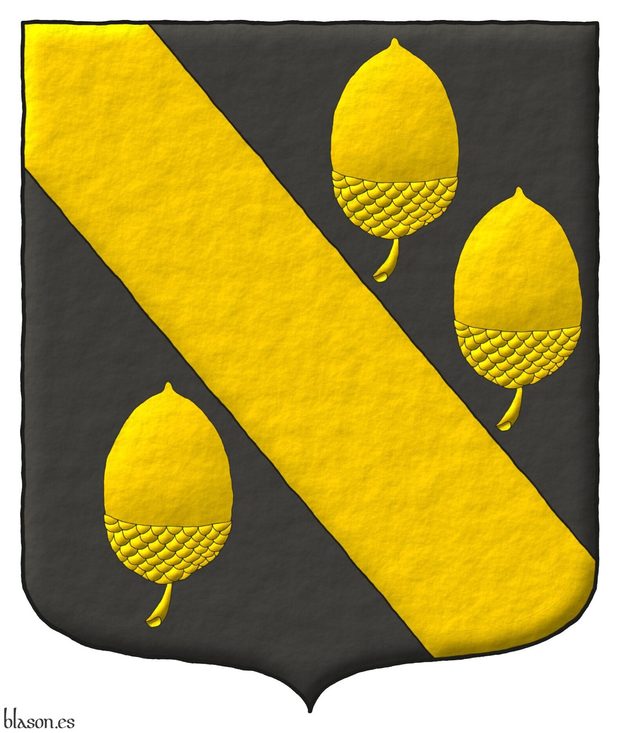
Ackerson and Akers lineages.
Sable, a Bend between three Acorns Or.
Illuminated and freehand finishing.
The coat of arms of Ackerson and Akers lineages emblazoned by me and extracted from [Burke, B.; 1989].
Unless the blazon specifies another layout, when a bend is between three charges, this charges are ordered, two in the chief and one in the base, as the three acorns do in this case.
[Rietstap, J. B.; 1861] escribe el blasón de «Ackers ou Akers» como «de sable, à une bande d'or, acc. de trois glands du mesme».
Blazon keywords: Sable, Bend, Between, Three, Acorn, Or and Ordered.
Style keywords: Freehand, Outlined in sable and Illuminated.
Classification: Interpreted.


![Ver [Cofradía de Santiago; Century XIV] en referencias bibliográficas. Libro abierto, hojas de plata, filo de oro, guardas de gules, tapas de sable.](../css/Libro.Bibliografia.png)
Cofradía de Santiago; Century XIV
Anonymous, «Libro de la Cofradía de Caballeros de Santiago de la Fuente», held by the Brotherhood of Santiago, Burgos Cathedral, manuscript, illustrated, 94 leaves, 21 missing, folio size, 29 x 21 centimeters, Burgos, 1338-1636.
Introduction
The illuminated manuscript chronicles the history and membership of the Brotherhood of Knights of Santiago in Burgos. Founded in 1338 during the reign of King Alfonso XI, as indicated by the preamble to the Rule on folio 27 verso, the Brotherhood was composed of members of the social and political elite of Burgos. The manuscript spans several centuries, primarily from the 14th to the 17th century.
The first 13 folios include a record of four deeds dating from 1396 to 1415, all related to the financial dealings of the Brotherhood.
Folio 14 marks the beginning of the original Rule of the Brotherhood, adorned with an illuminated initial «E» and a vignette of Christ flanked by saints and angels.
Portraits and illumination
The manuscript includes a list of the members, known as «cofrades» in Castilian, alongside their portraits and coats of arms. The book contains 295 portraits, added over time, with the last one dated to 1636.
The knights depicted in the manuscript held significant roles in the city, such as mayors, scribes, and other high offices. Many of the knights' families, like the Camargos from France and the Sanchestels from England, are noted for their diverse origins.
The portraits begin on page 21, initially with four to a page until folio 44, after which the number decreases to three, two, and eventually single figures per page.
Binding and preservation
The manuscript is bound in red leather with gold fillets and clasps, a 19th-century binding aimed at preserving the parchment pages. Originally, it had 94 leaves, but 21 are now missing, as noted in a contemporary annotation at the front.
Bibliographical reference of century XIV.
Classification: Manuscript, Armorial roll, Castilian language and In color.
Author: unknown.
Bibliographic reference mentioned in the following articles:
Internal resources: 86 images in JPEG format.


![Ver [Académie internationale d'héraldique; 1952] en referencias bibliográficas. Libro abierto, hojas de plata, filo de oro, guardas de gules, tapas de sable.](../css/Libro.Bibliografia.png)
Académie internationale d'héraldique; 1952
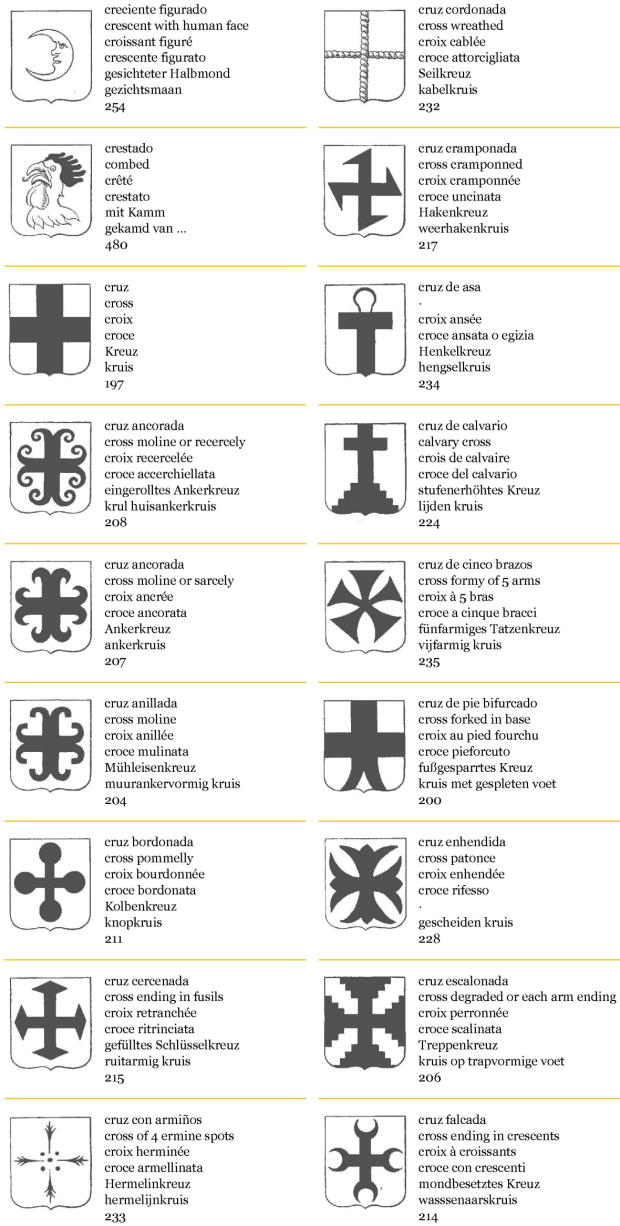
Académie internationale d'héraldique, AIH, «Vocabulaire-Atlas Héraldique en six Langues: Francais - English - Deutsch - Español - Italiano - Nederlandsch», by Gaston Stalins, Le Baron Stalins, with the collaboration of René Le Juge De Segrais, Ottfried Neubecker, Martin de Riquer y Morera, Giacomo Carlo Bascapé, and Mario Gorino-Causa, 119 pages, 530 black and white heraldic pictures, Société du Grand Armorial de France, 179 Boulevard Haussmann, París, 1952.
This book begins with the following sentence: «Heraldique - science et art - qui prit naissance en France vers la moitié du XIIe siècle, s'est propagée très rapidement dans les principaux pays européens».
The number of terms and words of the heraldry by languages is as follows:
- French language: 523 heraldic terms.
- Dutch language: 521 heraldic terms.
- German language: 519 heraldic terms.
- Spanish language: 511 heraldic terms.
- Italian language: 506 heraldic terms.
- English language: 502 heraldic terms.
The names of the authors and collaborators have been checked with [Académie internationale d'héraldique; 1999].
Its 530 heraldic illustrations correspond, according to my calculations to 509 drawings, numbered from 1 to 530. Some images contain several numbers, for example, the image that shows a coat of arms with its mantling, number 528, and its supporters, number 529, a griffin and a lion rampant, it is the same illustation, but with 2 numbers.
Bibliographical reference of century XXI.
Classification: Dictionary, French language, English language, German language, Castilian language, Italian language and Dutch language.
Authors:
- Stalins, Gaston.
- Le Juge De Segrais, René.
- Neubecker, Ottfried.
- Riquer y Morera, Martin de.
- Bascapé, Giacomo Carlo.
- Gorino-Causa, Mario.
Here are the articles quoting this reference:
- Ermine
- Ixai Lanzagorta Ochoa, plain tincture
- Pile issuant from the base in the Dictionary of the Spanish Language
- Sanz Lacorte, J.; 2007
- Sir Thomas Grenville II
- Val'Quirico, wreath an owl
External link:
Internal resources: Aih1952.00.Vocabulaire.Original.pdf, Aih1952.01.Vocabulaire.Sefidn.pdf and Paper edition with a Swedish bookplate.


![Ver [Martinena Ruiz, J. J.; Menéndez Pidal de Navascués, F.; 2001] en referencias bibliográficas. Libro abierto, hojas de plata, filo de oro, guardas de gules, tapas de sable.](../css/Libro.Bibliografia.png)
Martinena Ruiz, J. J.; Menéndez Pidal de Navascués, F.; 2001
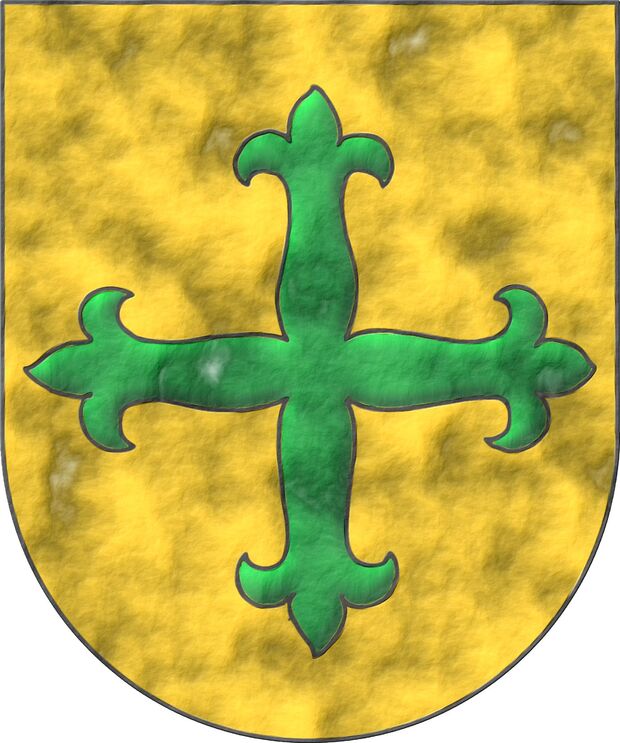
Juan José Martinena Ruiz and Faustino Menéndez Pidal de Navascués, «Book of Armory of the Kingdom of Navarra», Published by the Institución Príncipe de Viana, Directorate-General for Culture, Government of Navarra, 484 pages, ISBN-13 978-84-235-2166-1, ISBN-10 84-235-2166-4, Pamplona, 2001.
Reproduction and transcription of the manuscript armorial [Bosque, J. del; 1540], that is, the copy of the «Book of Armory of the Kingdom of Navarra», preserved in the General Archive of Navarra.
The coat of arms accompanying this bibliographic reference is that of Rada de Navarra following Juan del Bosque.
Both authors had already written and published, separately, about the armorial [Bosque, J. del; 1540], an example of the first is [Martinena Ruiz, J. J.; 1982] and an example of the second is [Menéndez Pidal de Navascués, F.; 1974].
Bibliographical reference of century XXI.
Classification: De bibliotheca.
Authors: Martinena Ruiz, Juan José and Menéndez Pidal de Navascués, Faustino.
Here are the articles quoting this reference:
External resources:

Continue with: Febrer, J.; Century XIII.
-
Language
-
Categories of heraldry
-
Divisions of the field
- Without divisions
- Party per pale
- Party per fess
- Party per bend
- Party per bend sinister
- Tierce
- Tierce sinister
- Tierced per pale
- Tierced per fess
- Tierced per bend
- Tierced pallwise inverted
- Quarterly
- Quarterly per saltire
- Gyronny
- Party per fess, the chief per pale
- Party per pale, the sinister per fess
- Party per fess, the base per pale
- Party per pale, the dexter per fess
- Chapé
- Chaussé
- Embrassé
- Contre-embrassé
- Party per chevron
- Enté
- Enté en point
- Flanched
-
Metals
-
Colours
-
Furs
-
Other tinctures
-
Ordinaries and sub-ordinaries
-
Diminutives of the ordinaries
-
Geometric charges
-
Composite ordinaries
-
Inanimate charges from Nature
Atom, Crescent, Diamond, Emerald, Estoile, Increscent, Lightning flash, Moon, Mount, Mullet, Mullet of four points, Orbital, Plough of Ursa Major, Rainbow, Ray of the sun, River, Sea, Snowflake, Sun, Sun in splendour, Sun of May, Trimount, Water and Wave.
-
Vegetal charges from Nature
Acorn, Apple, Apple tree, Ash, Bluebonnet, Camellia, Chrysanthemum, Cinquefoil, Cornflower, Dogwood flower, Double rose, Elm, Fleur de lis, Flower, Gourd, Holm oak, Hop cone, Kapok tree, Laurel, Lily, Linden, Lotus flower, Madonna lily, Mexican cedar tree, Oak, Olive tree, Palm tree, Plantain plant, Pomegranate, Poplar leaf, Rose, Shamrock, Sunflower, Thistle, Tree, Tulip, Vine and Wheat.
-
Animal charges from Nature
Badger, Bald eagle, Barbel, Barn owl, Bear, Beaver, Beetle, Bighorn sheep, Blackbird, Boar, Brach hound, Bull, Doe, Dog, Dolphin, Dove, Eagle, Elephant, Falcon, Female figure, Fish, Flame, Fly, Fox, Frog, Goat, Goldfinch, Goose, Heron, Horse, Hummingbird, Jaguar, Lark, Leopard, Lion, Lion passant, Lion rampant guardant, Lioness, Lynx, Male figure, Martlet, Merino ram, Owl, Panther, Parrot, Peacock, Pelican, Pelican in her piety, Puffin, Quetzal, Raven, Roe deer, Rooster, Savage, Seagull, Serpent, She-wolf, Stag, Starling, Talbot, Tyger, Vulture, Warren hound and Wolf.
-
Parts of natural charges
Arm, Beak, Branch, Caboshed, Chest, Claw, Covert, Dorsal fin, Eagle claw, Ermine spot, Escallop, Feather, Foot (palmiped), Foreleg, Forepaw, Hand, Head, Heart, Hoof, Leaf, Neck, Ostrich feather, Palm frond, Paw, Roe deers' attires, Shoulder, Sprig, Stags' attires, Stem, Swallow-tail, Tail, Tail addorsed, Tail fin, Talon, Tooth, Trunk, Trunk (elephant), Two hands clasped, Two wings in vol, Udder, Wheat spike, Wing and Wrist.
-
Artificial charges
Ace of spades, Anchor, Anvil, Arch, Arm vambraced, Armillary sphere, Arrow, Axe, Bell, Bell tower, Beret, Bonfire, Book, Bookmark, Bow, Branding iron, Bridge, Broken, Buckle, Cannon, Cannon dismounted, Cannon port, Canopy roof, Carbuncle, Castle, Celtic Trinity knot, Chain, Chess rooks, Church, Clarion, Clay pot, Closed book, Club, Column, Comb, Compass rose, Conductor's baton, Cord, Covered cup, Crozier, Crucible, Cuffed, Cup, Cyclamor, Dagger, Double vajra, Drum, Ecclesiastical cap, Fanon, Federschwert, Fleam, Four crescents joined millsailwise, Galician granary, Garb, Gauntlet, Geometric solid, Grenade, Halberd, Hammer, Harp, Host, Hourglass, Key, Key ward, Knight, Knot, Lantern, Letter, Line, Loincloth, Menorah, Millrind, Millstone, Millwheel, Monstrance, Mortar, Mullet of six points pierced, Nail, Non-classic artifact, Norman ship, Number, Oar, Oil lamp, Open book, Page, Pair of scales, Parchment, Pestle, Piano, Pilgrim's staff, Plough share, Polish winged hussar, Port, Portcullis, Potent, Quill, Ribbon, Rosette of acanthus leaves, Sabre, Sackbut, Sail, Scroll, Scythe, Sheaf of tobacco, Ship, Skirt, Spear, Spear's head, Stairway, Star of David, Step, Sword, Symbol, Tetrahedron, Torch, Tower, Trident, Trumpet, Turret, Two-handed sword, Wagon-wheel, Water-bouget, Wheel, Winnowing fan and With a turret.
-
Immaterial charges
Angel, Archangel, Basilisk, Dragon, Dragon's head, Garuda, Golden fleece, Griffin, Heart enflamed, Justice, Mermaid, Our Lady of Mercy, Ouroboros, Paschal lamb, Pegasus, Phoenix, Sacred Heart of Jesus, Saint George, Sea-griffin, Trinity, Triton, Unicorn, Winged hand and Wyvern.
-
External elements
-
Heraldic creations
-
References
-
Formats
-
Keywords on this page
Between, Proper, Armorial roll, Bend, Acorn, Bibliography, Boa, Created, Cristina, The Knights of, Quarterly, De bibliotheca, Outlined in sable, Dictionary, Dexter, Two, In black and white, Black and white with color plates, In color, Sword, Photographic, Hilted, Gules, Illuminated, Imaginary, Badge, Interpreted, German language, Castilian language, French language, English language, Italian language, Dutch language, Valencian language, Wolf, Manuscript, Ordered, Or, Poplar leaf, Passant, Comb, Argent, Without divisions, Kingdom of Navarre, Rough, Sable, Century XIII, Century XIV, Century XIX and Century XXI.

